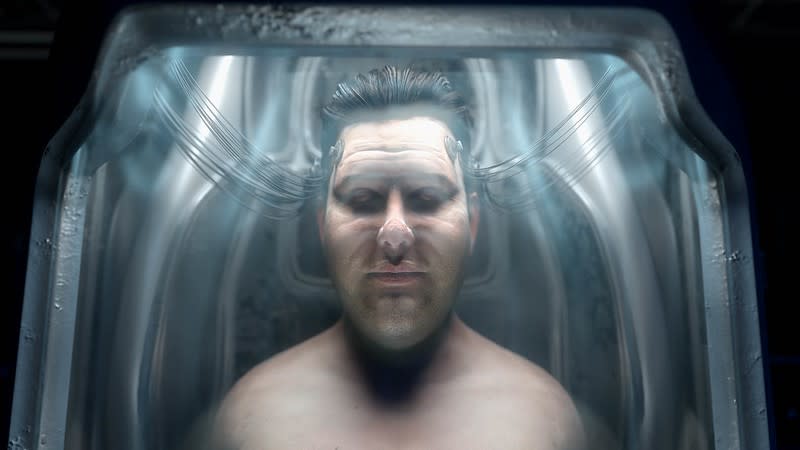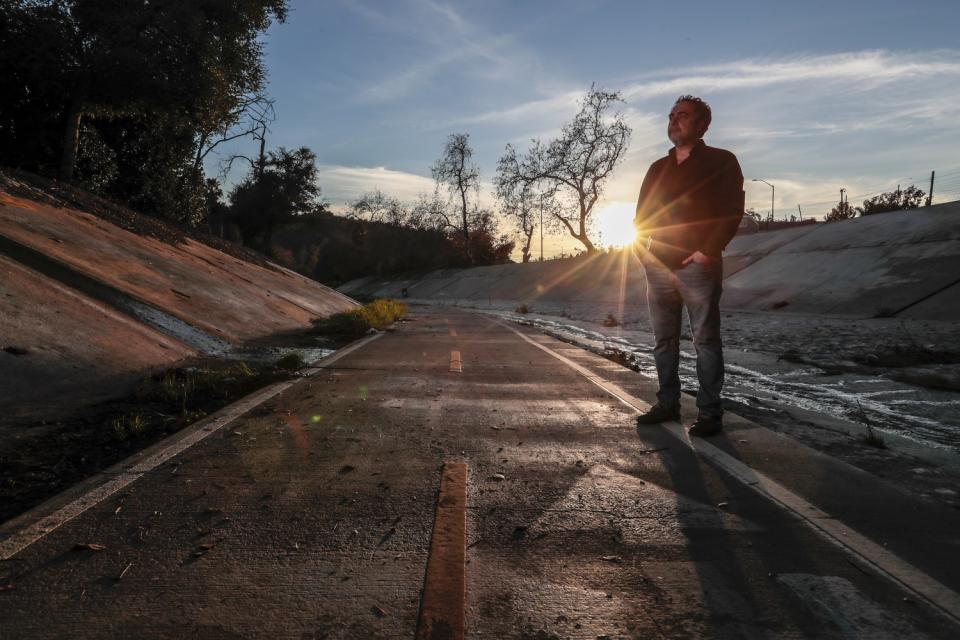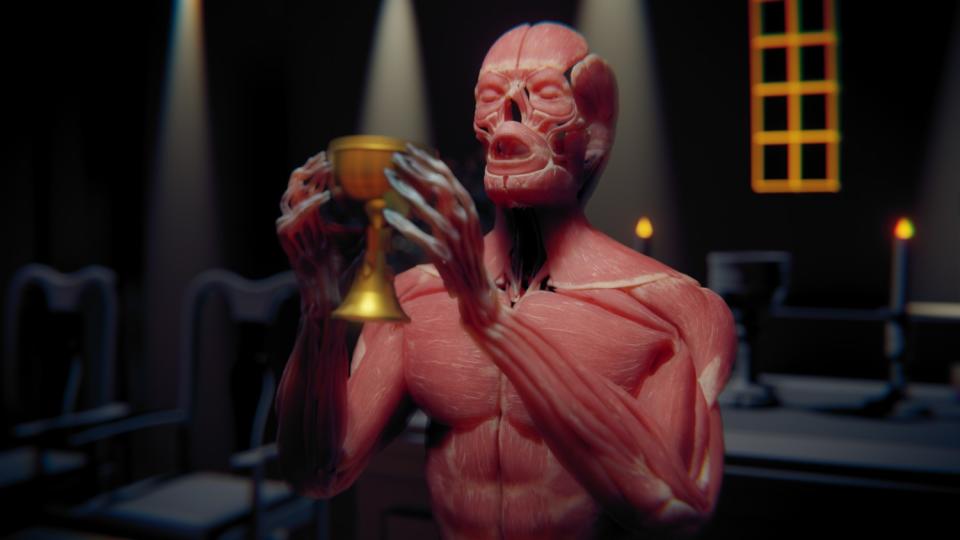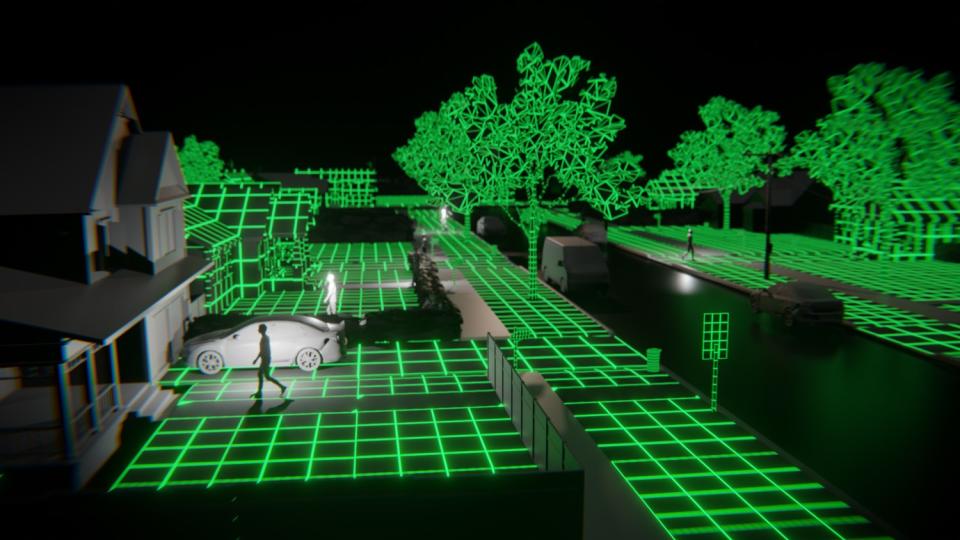Is real life actually a simulation? A new documentary examines those who think they know

- Oops!Something went wrong.Please try again later.
Building his latest documentary around impossibly big questions, a cheeky '90s cyber aesthetic and the words of visionary author Philip K. Dick, director Rodney Ascher explores the labyrinthine terrain between science fiction and reality in "A Glitch in the Matrix," tackling an age-old conundrum: Are we living in a simulation?
A genre filmmaker whose natural inquisitiveness lent itself to feature documentaries — including 2012's "Room 237," about Stanley Kubrick's "The Shining," and 2015's sleep paralysis exploration "The Nightmare" — Ascher now explores another niche corner of humankind's search for meaning and truth. But as he dove deeper into "Matrix," the film took an unexpected turn.
"I didn’t know that it was going towards horror; I thought it was going towards science fiction," said Ascher, whose film, conceived before the pandemic and completed remotely during it, premiered at this year's virtual Sundance Film Festival.
Blending sci-fi cinema and video game iconography, the academic theories of experts such as Oxford philosopher Nick Bostrom and firsthand musings from "eyewitnesses" who are transformed on screen into otherworldly CG avatars, "Matrix" explores wide-ranging implications of simulation theory with imaginative, pop culture-infused flair.
In its most chilling and controversial sequence, "Matrix" employs photogrammetry and eerie computer animation to re-create the 2003 night when teenager Joshua Cooke, obsessed with the 1999 film "The Matrix," murdered his parents. The case spawned the "Matrix defense," in which a defendant claims they believed they were in a simulation of the real world. Cooke is interviewed in the film from prison, where he is serving a 40-year sentence.
Beaming in via videochat, Ascher discussed the methods and origins of the film and considered the ways it has garnered unexpected relevancy since it first began. The film is now available on VOD and in virtual cinemas.
"We’re in a world where there are not just disagreements about opinions, but disagreements about facts," he said. "And I like to think that this project can be a good entryway into talking about that stuff — maybe as a piece of self-examination, wondering, if we’re all living in our own Plato’s Caves, how accurate are the shadows that we choose to spend the most time looking at?"

You made this film before our new pandemic reality set in, but "A Glitch in the Matrix" uses language that we're now all-too accustomed to in our daily lives: Subjects are interviewed over Skype, through screens, and are even presented in avatar form. How prescient does that choice feel now?
It looks like the conversation that we’re having right now, you and me, but we actually shot the interviews in 2019. It’s a very strange coincidence that a movie that is built on these Skype calls, these webcam video calls, is getting released into a world in which we’re all interacting with each other through these images. In some ways having an avatar speaking to people in these interviews, people speaking in their real world environments, might seem a little bit like a satire of the first few COVID-19 projects that have hit. Or just the way that we live. A very strange coincidence, but not the only one.
Have you experienced instances of déjà vu, glitches or synchronicities you can’t explain?
Synchronicities, for sure. Even in the course of this film. The name that [Dick] came up with for the day that he had this big revelation in February and March of 1974, he called 2-3-7... 4. ["Room 237," Ascher's documentary about "The Shining," is titled after a motif in the Kubrick film.] Philip K. Dick wrote extensively about Martian colonies, and ["Glitch in the Matrix" subject] Jesse [Orion] thinks we need to colonize Martian planets in order to get our message out to the creator. And, Elon Musk is working on a Mars colony. All three of them are thinking Mars is the place.
Are you endorsing Elon Musk as a voice of authority on the matter?
I’m saying Elon Musk is a Philip K. Dick-esque character. As a globe-trotting outer space executive who’s fascinated with the idea of simulation theory, the fact that he, Philip K. Dick and Jesse Orion were all speaking actively of Martian colonization, struck me as significant. His speech gave a lot of people permission, and Jesse talks about it explicitly: If somebody as rich, famous and powerful as [Musk] believes in it, maybe there’s something to it.
Had you been thinking about simulation theory for a long time when you began developing "Glitch in the Matrix"?
One of the people I spoke to for "The Nightmare" believed in simulation theory. He was the first person who turned me onto the idea that it wasn’t just an idea from science fiction movies — it wasn’t just "The Matrix," "eXistenZ," "The 13th Floor," but that people were taking it seriously and that physicists were trying to see if they could look at the end of the universe and whether it broke down into a particular scale of pixel, and what that meant. That blew my mind. It was the beginning of a rabbit hole that I still haven’t been able to crawl out of.

After making this film do you, in fact, believe that we are in a simulation?
I have no idea. I think I understand Nick Bostrom’s three-part simulation hypothesis better than I did going in, although I don’t necessarily understand whether all three branches are equally weighted. And I don’t necessarily understand the bleeding edge of quantum physics and where science comes down on simulation theory, although I do know that people smarter than me, like Neil DeGrasse Tyson and Elon Musk, think of it as plausible.
What I take away from it is more simulation theory as a creation story, as an article of faith: that countless traditions and cultures have stories that explain how we got here, where the universe comes from, and in many ways this could be just another one of them. I was surprised going into this and talking to people, how quickly it became a religious question — not just, "Is the creator some fifth-grader cramming for their exam over the weekend on another planet or in the future?" but, "If this is a simulation, what does that mean about our relationship to other people?"
Because the first fork in the road is, are we playing "Pac-Man" — where you’re the only player and everybody else is a phantom ghost — or is this "Fortnite," where every character is tethered to a real human being? Where you come in on that fork, whether other people are real too, has extraordinary ramifications for how you live. I see it in the people who mistreat service workers because they’re an obstacle along the way of getting what they want. How that phrase "NPC" [non-player character] has terrifying connotations of thinking of people that way, and that rippling out, was one of the surprises of this project.
The Joshua Cooke sequence marks a turning point in the film, when hypotheticals collide with real world consequences and go to a very real, horrifying place. How did you measure how much of his story to include, and how to go about it?
In the early days I had a big whiteboard with every idea I could think of related to simulation theory. One of the early ones was the "Matrix defense," the fact that people had used simulation theory as part of a criminal defense to explain an insanity defense that they weren’t liable for their actions because they didn’t realize the real world implications; they thought they were living in a simulated reality. I wanted to get something about the "Matrix defense" into the film, and there was really only one person who used it. [Cooke's lawyers at the time considered using the defense; he ultimately pleaded guilty.]
[Producers] Rebecca Evans and Colin Frederick found Joshua, and Joshua’s at a place in his life where he’s just written a self-published book on Amazon and he’s trying to reach kids to try to help prevent them from repeating his mistakes, trying to learn from what he went through and be a better person, work on himself and reach out to kids who are in a similar space. So he was anxious to retell the story. I spoke to him a few times on the phone from an administrator’s office, but ultimately the recording that’s used in the film came from a pay phone in the common area, so you sometimes hear other people in the room — a little fight breaks out, you can hear some shouting echoing off the metal walls from time to time.

How careful did you decide you should be with that depiction?
Some people have taken exception to that story’s inclusion in the film. I get it. It’s a pretty troubling sequence in a lot of ways. As I was working on the film, it seemed more and more important to go from abstract speculation to nuts-and-bolts reality, and to especially drill down into some of the real-world consequences of this kind of thinking and the dangers of it. I still find it perfectly fun sometimes to bat simulation theory around and think about some of its implications, but there can be a real danger in disassociating and becoming alienated from reality, and not necessarily believing in the world around you or the people around you... you look around where we are today; people building up false ideas about reality has dangerous consequences all around us, in a thousand different ways.
When it came time to talk about the murder itself and what that was going to look like, I didn’t want there to be animated cartoon characters in it in a way that would make it silly. That would be wildly inappropriate even by my standards, which might be looser than other people’s.
The idea of it was not looking at the night through his eyes as he moves through the house as he describes it but more of him 15 years later remembering it — and that it’s a memory that’s starting to fray around the edges. He’s narrating it in a very specific, blow-by-blow kind of way, and I think back to "The Shining." What frightened me as a kid when I snuck into a screening when I was 13 was the Steadicam — that even though this was a bad place, the camera dragged you into it and it almost felt like the floor was so well polished that even if you planted your feet, you would be dragged forward against your will.
The momentum of [animation director] Lorenzo [Fonda]’s ghostly camera moving through the rooms, even if you want to put on the brakes, has that kind of eerie, terrifying feeling. And it is a terrifying story. The terror is about making a horrible mistake. It’s not about danger happening to you, it’s about you doing something that you can’t undo.
You mention the dangers of people living in false realities today. How have you seen the film's themes ripple out into real world events, even after finishing the film?
Clearly the last couple years have shown us the dangers of people creating worlds that, however much they’re at odds with reality, they’re certainly at odds with other people’s realities. We’re in a world where there are not just disagreements about opinions, but disagreements about facts. And I like to think that this project can be a good entryway into talking about that stuff — maybe as a piece of self-examination, wondering, if we’re all living in our own Plato’s Caves, how accurate are the shadows that we choose to spend the most time looking at? Assuming they’re telling us the truth about the world around us. How carefully are we vetting where they’re coming from, or whether they were created in good faith, by journalists working their asses off communicating to us what they find out there, or cynically by folks who are trying to manipulate us to other ends?
There are specific political controversies that that talks about today. But I’m perfectly happy for them not to be directly in the film, so that as time goes on you can substitute the next three or four horrifying things that are waiting for us.

When you set out to find interview subjects for this film, you put out a call online. What kind of responses did you get?
There were maybe 75 or 100 people who wrote us, and I probably talked to 15 or 20 of them at a similar length to the ones who appeared in the film. It’s been noted that all four of them are white men, and that’s certainly something I noticed in the course of making it. That was also who dominated the replies. I think it’s fair to ask: Is there something about simulation theory that appeals more to white men?
It’s certainly a conversation that’s worth continuing to have. Again, it’s a pretty small sample group so I’m not sure if it’s statistically significant or just the way that it broke in our experience. If the tech world is dominated by white guys, maybe there’s something reassuring to them that the creator of the world is more like them. During the [Sundance] Q&A, Paul [Gude] suggested that as a white guy because he’s coming from a place of privilege maybe he feels more comfortable sharing this idiosyncratic part of himself than other folks might feel. There might be something to that.
Your film is framed by a Philip K. Dick lecture from 1977 in which he speaks to an audience about his belief in simulation theory. Why was that an important piece of the puzzle for you?
A five-minute version of it that I found on YouTube made me want to include it as a speech that’s a milestone in the mainstreaming of simulation theory, and it made me want to find out what else he said. Watching the entire thing, which was 40 or 50 minutes long, was kind of a revelation. I had to watch it two or three times to get my head around it because some of it is pretty complicated, and a little gnarled.
The thing I love about the speech and [why I] included it in the film is that movies based on Philip K. Dick stories — even though "The Matrix" is not one, in many ways it shows his influence — helped people understand the idea of simulation theory. Probably "Total Recall," more than many of the others. It’s been said that the two ideas that he focused on in book to book to book were, "What is real?" and "What is human?" Which is also the question of [non-player characters], artificial intelligence and how far away are we from a robot or a computer program that deserves human rights?
And what if... we are those robots?
Exactly. So he was a great figure to consider, as well as the fact that in many ways the audience doesn’t seem especially captivated by his speech. They were probably expecting him to talk about his books. But if those ideas sounded kind of crazy in 1977, he was suffering the anxieties of a rising authoritative police state and of loss of privacy and of information out of control, and the idea that we may be in a false world. He seems to have been suffering from neuroses and fears that are so much more common today — like he was patient zero of the 21st century existential crisis.
This story originally appeared in Los Angeles Times.

